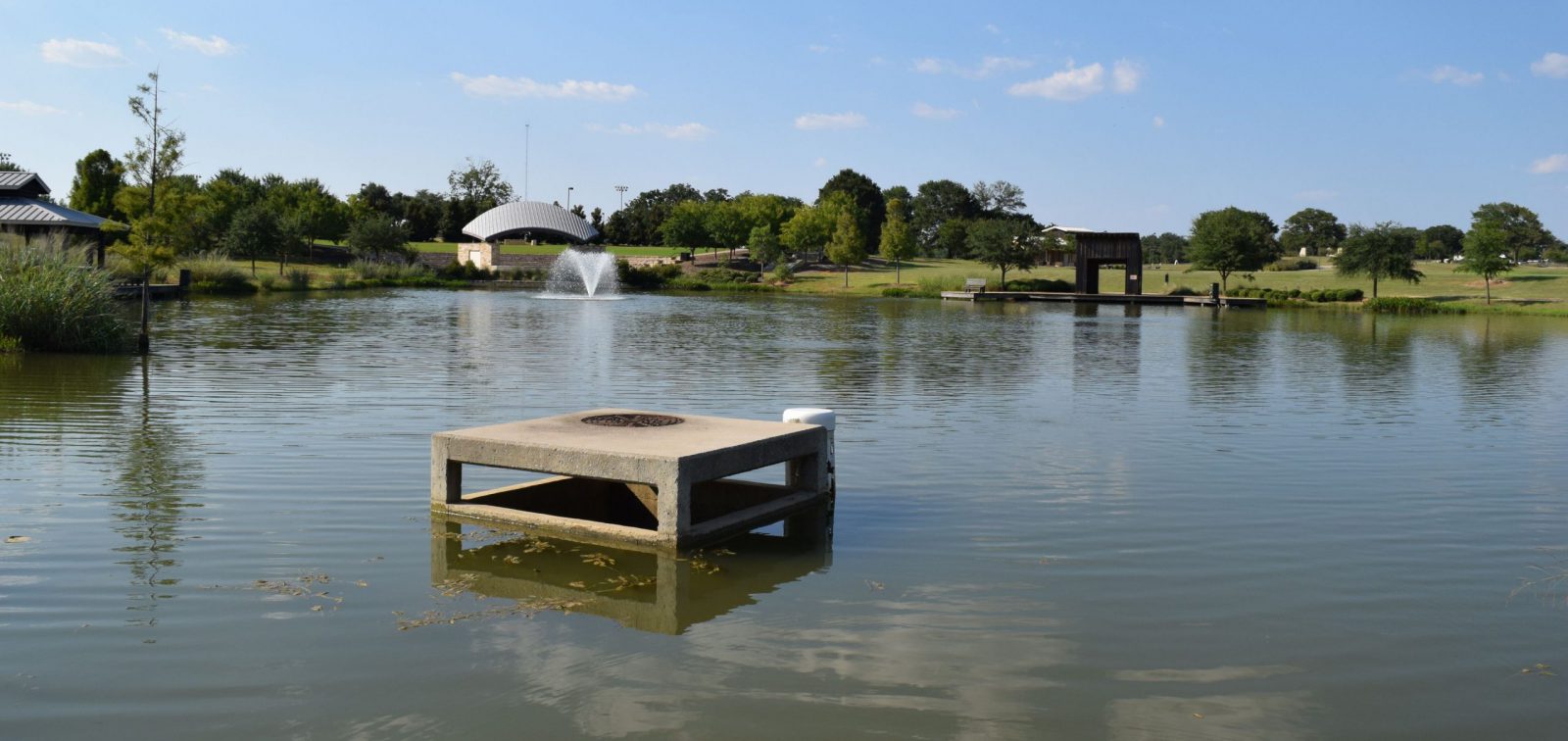
Strategies and Techniques for Aging Stormwater Management Ponds
As ponds and lakes age, they become increasingly impacted by the effects of sedimentation and the accumulation of organic matter. Sedimentation is the primary issue threatening most freshwater bodies, and because nutrients are absorbed to sediment particles, a heavy sediment load to a pond or lake also means that nutrients are entering in large quantities. Sediment washes in from the surrounding watershed, eroding from unstabilized ground and the banks of the incoming stream channels. Organic matter is another source of nutrients, and enters the pond in various forms such as leaf litter, woody debris, and animal waste. It can also be produced within the pond in the forms of aquatic vegetation growth and the flesh and waste of fish and other aquatic organisms.
As organic matter accumulates in a waterbody, the excessive nutrients cause impaired water quality and reduced aesthetics. This aging process, known as eutrophication, contributes to algae and cyanobacteria blooms, surface biofilms, dense submersed plant growth, and related oxygen depletion. Severely impaired ponds will have foul odors, unwanted vegetation filling most of the surface and water column, and will not be habitable by aquatic organisms or usable for recreation.
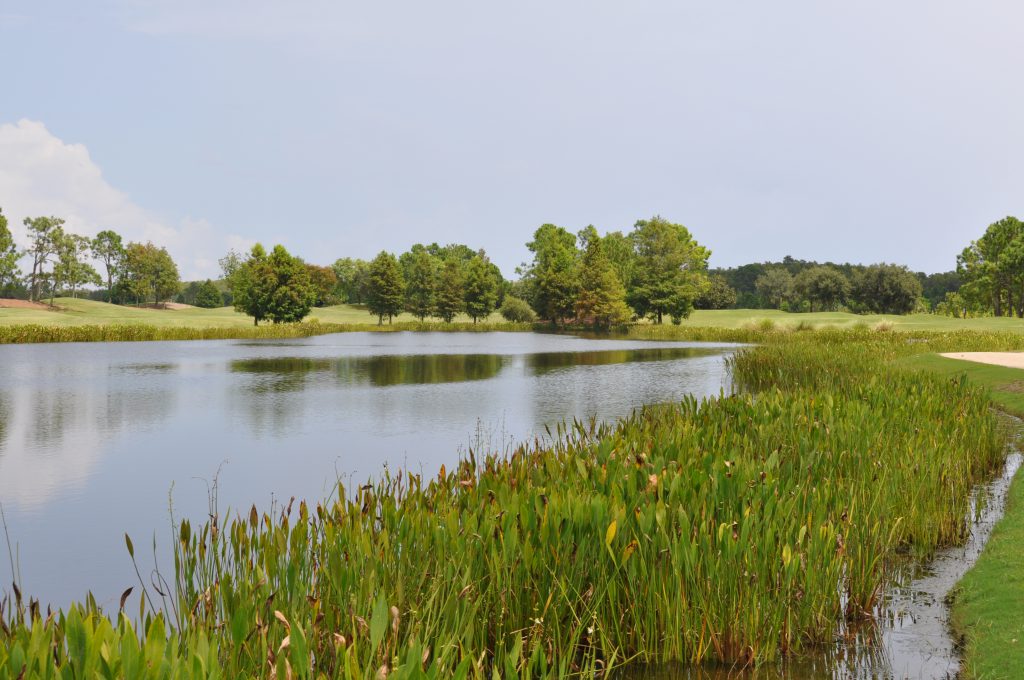
or newly constructed ponds and lakes, a long-term proactive management plan should be implemented that includes strategies to prevent nutrients and sediment from entering water bodies. Dense buffers of native vegetation are recommended around the shorelines of ponds and lakes to filter runoff. Shoreline stabilization around the pond and in the upstream channel will prevent erosion of the soil and the associated nutrient loading. Forebays can be installed to trap sediment in a small area near the mouth of the pond to facilitate frequent and small-scale removal. However, preventive strategies have little effect on ponds that are already impaired, and mitigation efforts within the water bodies are required to reverse the effects of long-term eutrophication.
We have worked with a community in Ashburn, Virginia for over 10 years, and have implemented a multi-staged program for their six stormwater management ponds to help them allocate their pond maintenance funds in a proactive and organized way. When the ponds were initially released from the construction bond and turned over to the HOA, preventive strategies were focused on how to maintain the water bodies. Baseline stormwater inspections were performed to identify structural issues and erosion areas that were contributing sediment to the ponds. Two of the ponds had severely eroded shorelines, and biologs were installed with emergent vegetation plugs to provide a long-term solution. Riparian buffers were established around the ponds to filter the incoming runoff from the surrounding lawns. An annual maintenance program was set up to monitor the ponds and address nuisance aquatic vegetation issues.
There are numerous strategies that can be implemented as part of a pond maintenance program to minimize the effects of eutrophication. One of our primary recommendations for all of our clients is to install an aerating fountain or a diffused air aeration system. Pond aeration helps to improve circulation of the water column and improves dissolved oxygen levels throughout the waterbody. Surface aerators produce spray patterns with water droplets that add oxygen to the water and create wave action to enhance circulation. Submersed diffused air systems produce air bubbles that lift and circulate the hypoxic water from the bottom of the lake, thus increasing the interaction of the entire water column with atmospheric oxygen. In general, aeration encourages the growth of beneficial bacteria, which compete with algae for excess nutrients, and also break down decaying organic matter.
Because of the aesthetic appeal of floating fountains, the HOA client in Ashburn was able to get broad support from homeowners to install surface aerators in two of the ponds immediately, and one was budgeted for the following year. Initially, the ponds were easy to maintain, and the nuisance vegetation control strategies included in the annual maintenance plan were adequate to maintain the ponds in a healthy and aesthetically pleasing state. However, because Ashburn is in a fast-growing area of Loudoun County, it did not take long for the effects of heavy sedimentation and fertilizer-laden runoff to manifest in the ponds, and the algae and nuisance vegetation issues in the ponds continued to worsen with each growing season. It was necessary to supplement the existing management plan with additional services to address the new conditions.
Another strategy to reduce eutrophication in ponds is inoculation with supplemental beneficial bacteria. There are many different types of bacteria, which work in different ways to break down organic compounds. Since the bacteria convert nutrients into unavailable forms, they can be beneficial in reducing nuisance algae blooms in ponds and lakes. In fresh water, phosphorus is generally the limiting nutrient for algal growth. The ratio of nitrogen to phosphorus determines the types of algae that will grow and thrive in a pond. In situations where there is excess phosphorus, nuisance species of filamentous and blue-green algae (cyanobacteria) will dominate the pond instead of the beneficial planktonic green algae that form the base of the food web.
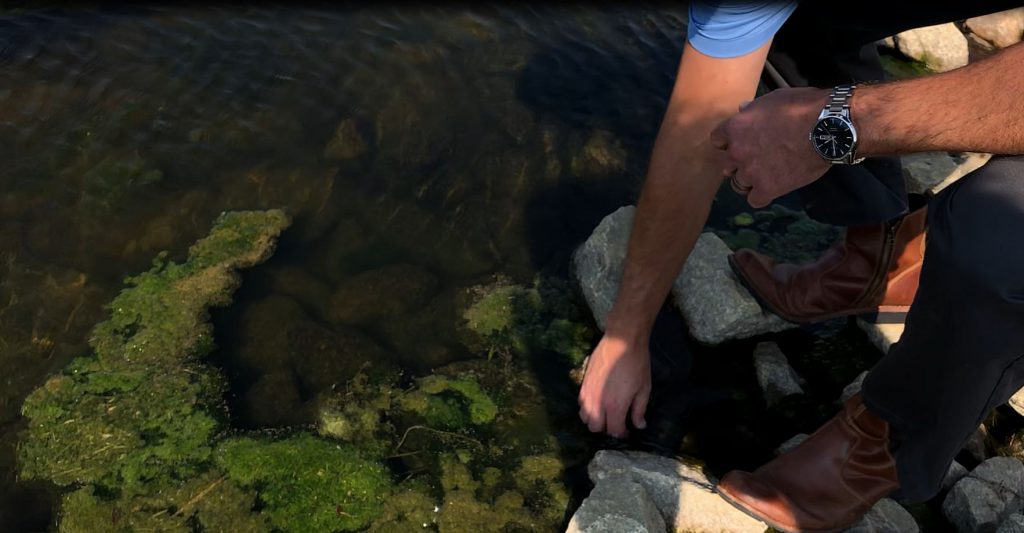
Bacteria products are often used in our annual pond maintenance programs for algae control, organic waste degradation and general water quality improvement. These products can be supplemented with a formulation of bacteria and enzymes specifically geared towards digesting the organic matter that builds up on the pond bottom. This process, known as biological dredging, can actually decrease the thickness of the sediment layer on the bottom of a pond. Some of the enzymes are targeted to break down specific compounds, such as the cellulose found in leaves and sticks that accumulate in the pond. While this process does not address the build-up of inorganic soil particles, it can greatly increase pond depths and decrease the amount of organic bottom sludge.
Unfortunately, many of the stormwater ponds in the Ashburn community are very large (greater than two acres), and it was not within the HOA budget to include the use of beneficial bacteria in the annual maintenance program. However, within five years of implementing the plan, it became obvious that additional strategies were going to be necessary. The smallest pond on the property had such severe algae growth that rotating algaecide applications at the maximum frequency and rates, indicated on the product labels, were not sufficient to control the blooms. The pond is extremely shallow by design, and receives heavy amounts of leaf litter each fall. Because the pond is only about 1/10 of an acre, we were able to implement an inexpensive biodredging program during the summer of 2006, and have continued to include beneficial bacteria applications for that pond only as part of the regular maintenance plan for the facility without a drastic increase in the cost of the program. The is pond is now one of the more easily maintained facilities on the property, requiring only two or three minimal algaecide applications during the growing season each year.
In many of the larger waterbodies, though, invasive submersed vegetation species such as curly-leaf pondweed, brittle naiad, and hydrilla have become established. Periodically, triploid grass carp is stocked in these ponds, and an early season Sonar Low-dose Application Method (fluridone SLAM) program is implemented as part of the maintenance plan, which has typically provided season-long control of these species. However, frequent and persistent algae blooms have been increasingly difficult and expensive to manage. Fortunately, the HOA was able to obtain additional funds in 2008 to install submersed diffused air aeration systems in two of the most troublesome ponds, which did suppress the growth to a more manageable level for a few years. But the problems resurfaced with a vengeance during the 2012 and 2013 growing seasons.
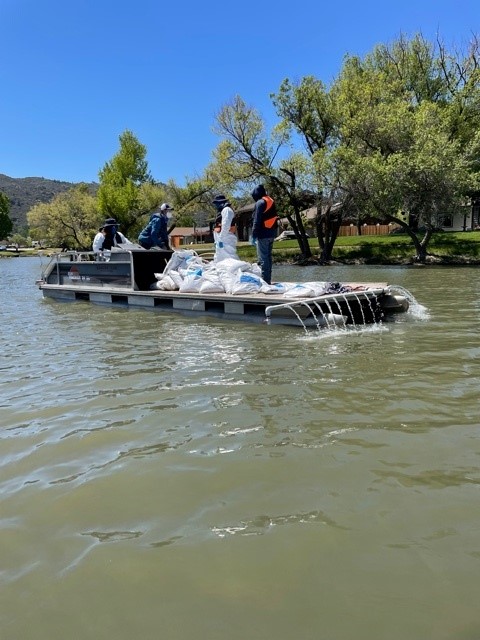
Unfortunately, the ponds in this community were constructed in the late 1980’s, and most are approaching the timeframe when maintenance dredging will be required. Obviously, mechanical dredging to remove the accumulated sediment and organic matter is the most direct and effective mitigation strategy to reverse the effects of eutrophication, and we have recommended that the community perform bathymetric studies of the facilities and begin financial planning for a large-scale dredging project. However, this process is extremely disruptive and expensive, and an expenditure of this magnitude is not in their budget for several years. Our client requested recommendations for other strategies that can be employed for as long as possible while they save money for the project. The goal was to provide our client with a proactive, cost effective remediation strategy to improve the health and aesthetic appearance of their water bodies while prolonging the need for a full-scale dredging operation.
A promising new technique to minimize the effects of eutrophication is direct phosphorus mitigation using a product called Phoslock. The product, manufactured by SePRO, is a lanthanum-modified bentonite clay that can be applied to the water surface as a granule or a slurry to bond with free reactive phosphorus. The lanthanum adsorbs phosphate molecules to form a mineral called rhabdophane, which is extremely stable at in situ pH levels. Any unreacted lanthanum remains imbedded in the bentonite granules, which settle to the bottom of the pond to form a permeable layer that will continue to bond and sequester phosphorus as it releases from the sediments.
In order to implement an effective phosphorus mitigation strategy with Phoslock, it is essential to have a good understanding of the water quality in the pond, as well as the phosphorus levels in both the water column and the sediment. Ideally, sampling should be conducted in the absence of an active algae bloom to establish a baseline for the water quality and to calculate the total amount of phosphorus in the water body. Because 100 kg of the product can inactivate 1 kg of phosphorus, it is possible to calculate the amount of product required for mitigation based on the water and sediment testing with fairly high accuracy.
Water quality testing is important for other reasons as well. Assessing the impairment of ponds and lakes and classifying their trophic status by monitoring several key water qualities are indicators to estimate the total living algal biomass in the water body at the time of measurement. The three parameters used to determine the trophic index are chlorophyll concentration, phosphorus concentration, and Secchi Depth. Ponds that are classified as eutrophic or hyper-eutrophic on this scale are the most impaired and will exhibit the most severe health and aesthetic issues. It was suspected that most of the ponds in the Ashburn community would register very high on the trophic scale.
In the fall of 2013, water quality and sediment samples were collected from the two ponds that have historically required the most frequent herbicide treatments. Not surprisingly, the test results showed that both ponds are eutrophic, with total phosphorus levels of over 90 μg/L. Based on the results of the testing, we calculated the amount of Phoslock that would be required to mitigate the phosphorus that has accumulated in the ponds, and submitted a proposal to the HOA to apply the product in the spring of 2014. With a price tag of almost $20,000, it was questionable that the Board would approve the expenditure.
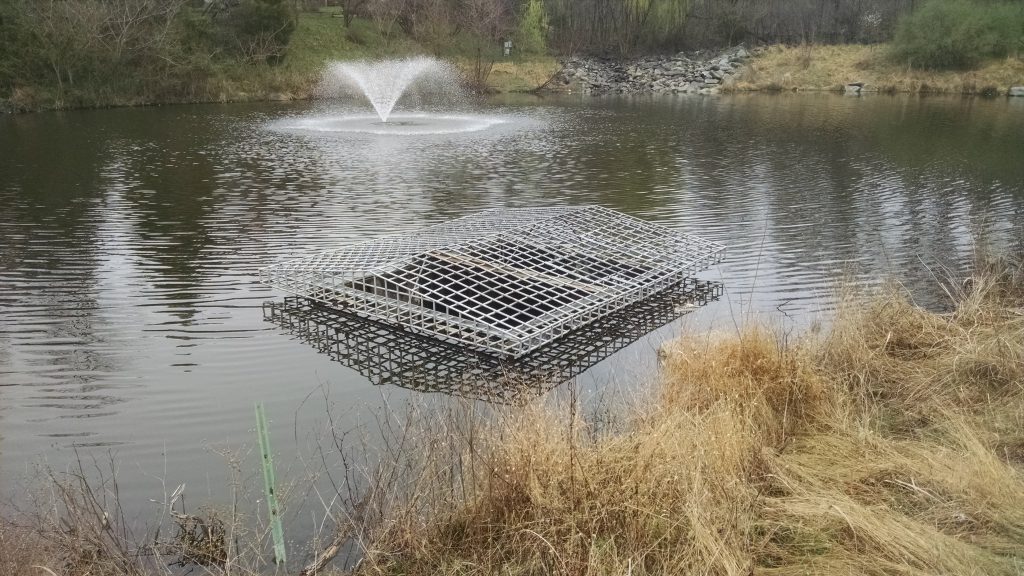
The physical application of the calculated quantity of the lanthanum-modified clay product can be performed all at once, or it can be phased over multiple years to compensate for budgetary considerations. Since most of the phosphorus in a water body has accumulated over many years, it is an acceptable strategy to stage the mitigation over several years as well. Once the initial phosphorus load is completely mitigated, annual maintenance applications can be performed to account for new inputs to the water body. However, once the mitigation plan is implemented, the results will be improved water quality and reduced issues with cyanobacteria and other algal species.
In a perfect world, everyone would install aeration systems, utilize beneficial bacteria, and implement phosphorus mitigation programs in order to counter the effects of nutrient loading to their ponds and lakes. However, in reality, few communities or private landowners can afford to implement all of these strategies at once. By evaluating the goals and budgets of pond owners along with the specific characteristics of their water bodies, a long-term, comprehensive management plan can be developed to provide the best use of limited financial resources.
Nutrient Remediation Technologies
SOLitude Lake Management is committed to providing full service lake and pond management solutions that improve water quality, preserve natural resources, and reduce our environmental footprint. Our services include lake, pond, wetland and fisheries management programs, algae and aquatic weed control, mechanical harvesting, hydro-raking, installation and maintenance of fountains and aeration systems, water quality testing and restoration, bathymetry, lake vegetation studies, biological assessments, habitat assessments, invasive species management and nuisance wildlife management. Services, consulting and aquatic products are available to clients nationwide, including homeowners associations, multi-family and apartment communities, golf courses, commercial developments, ranches, private landowners, reservoirs, recreational and public lakes, municipalities, parks, and state and federal agencies. Learn more about SOLitude Lake Management and purchase products at www.solitudelakemanagement.com.









